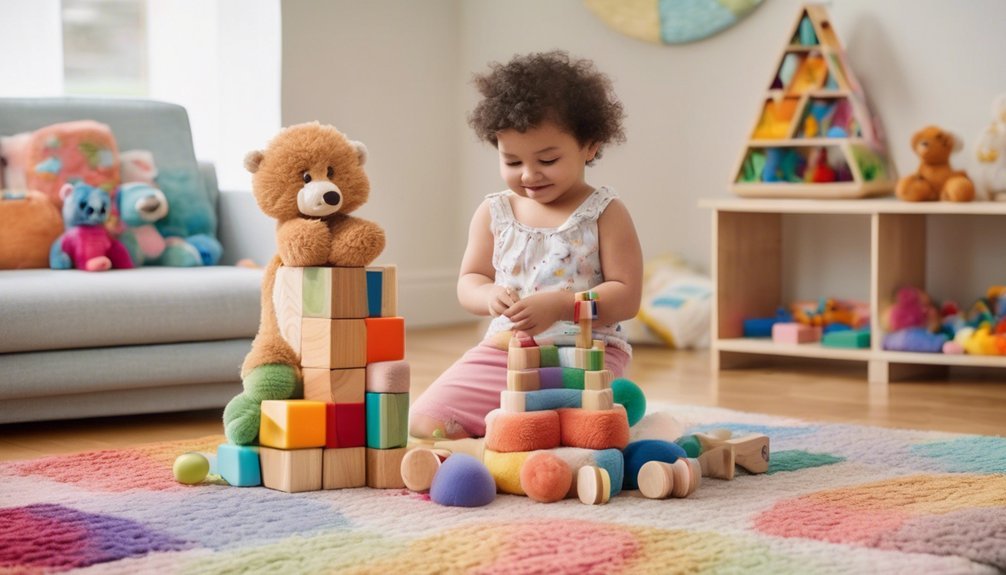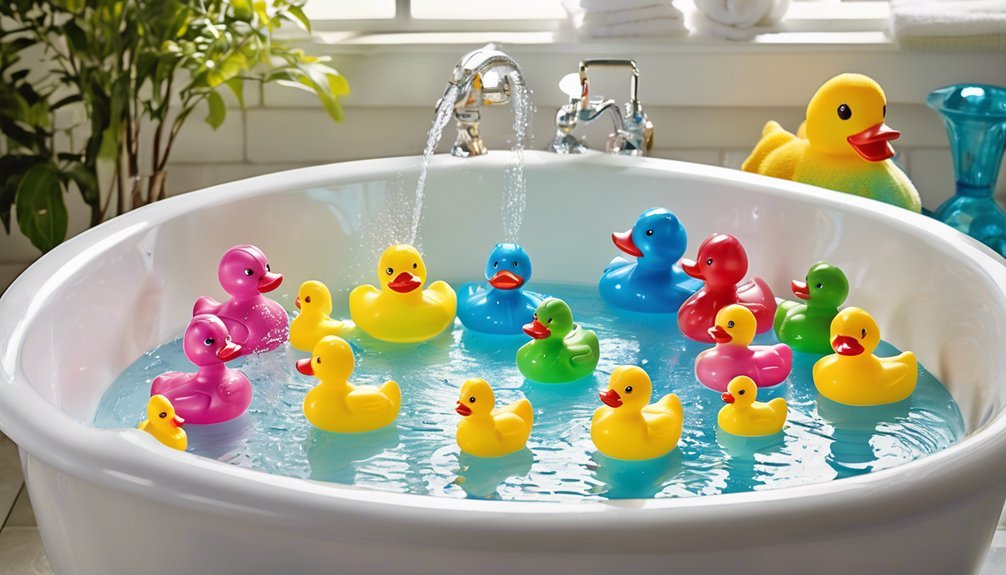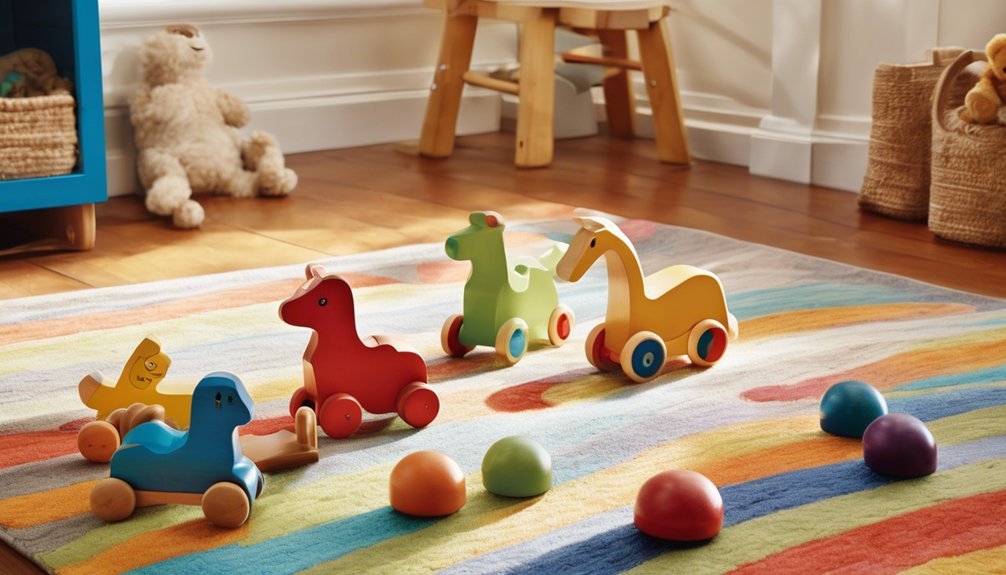Choosing the right educational toys for your infant can significantly impact their early development. These toys do more than just entertain; they stimulate sensory exploration, promote motor skills, and nurture cognitive growth. From stacking toys that build coordination to soft books that introduce literacy, the options are diverse. Understanding how each toy contributes to your baby’s growth can enhance their learning experience and strengthen your bond. Let’s explore the best choices available.
Key Takeaways
- Look for sensory toys that enhance exploration and discovery, stimulating cognitive growth and emotional development in infants.
- Choose stacking toys to promote fine motor skills, hand-eye coordination, and problem-solving through engaging play experiences.
- Select soft books that encourage early literacy, imaginative storytelling, and bonding during shared reading times with parents.
- Opt for musical instruments to foster cognitive development, enhancing memory and attention through musical exploration and cause-effect learning.
- Consider blocks and construction sets that stimulate creativity, spatial awareness, and collaborative play to strengthen parent-child relationships.
The Importance of Educational Toys for Infants

When you consider your infant’s development, you’ll find that educational toys play a crucial role in shaping their cognitive and physical growth. These toys foster early learning by stimulating curiosity and problem-solving skills.
As your little one interacts with colorful blocks or shape sorters, they’re not just playing; they’re engaging in activities that promote cognitive growth. Research shows that hands-on experiences enhance neural connections, paving the way for language development and critical thinking.
Moreover, educational toys encourage motor skills as your baby reaches, grabs, and manipulates objects. By providing varied learning opportunities, you’re setting the stage for a lifetime of exploration and knowledge.
Choose toys that challenge and inspire, allowing your infant to thrive in those vital early years.
Sensory Play: Engaging the Senses
Engaging your infant in sensory play can significantly enhance their learning experience. By introducing sensory bins filled with various materials, you’re creating an opportunity for exploration and discovery. These bins can include rice, beans, or water beads, allowing your little one to feel different textures and develop their sensory skills.
Textured toys are another fantastic option, providing tactile feedback that stimulates their developing senses. As your baby touches, squeezes, and manipulates these toys, they learn about cause and effect while improving their hand-eye coordination.
Sensory play not only captivates your infant’s attention but also fosters their cognitive growth and emotional development. So, dive into this enriching world together, and watch your baby thrive through joyful exploration!
Building Motor Skills With Stacking Toys
Stacking toys are an excellent way to help your infant build essential motor skills. As your little one explores different stacking strategies, they’ll develop hand-eye coordination and fine motor skills crucial for reaching developmental milestones.
These toys encourage grasping, balancing, and problem-solving, all while keeping your baby engaged and entertained. You might notice how your infant’s confidence grows as they successfully stack rings or blocks, reinforcing their learning through play.
Plus, stacking toys promote cognitive development by introducing concepts like size, shape, and gravity. So, the next time you sit down to play, consider how these simple toys can lay the foundation for your child’s physical and cognitive abilities, nurturing their growth in a fun, interactive way.
Soft Books: Introducing Reading Early

Soft books are a fantastic way to introduce your infant to the world of reading early on.
These fabric treasures not only foster early literacy but also encourage imaginative storytelling.
Here are three reasons to snuggle up with soft books:
- Durability: Made from soft materials, they withstand chewing and pulling, making them perfect for little hands.
- Colorful Designs: Their vibrant illustrations grab your baby’s attention, stimulating visual development and sparking curiosity.
- Interactive Features: Many soft books include textures, flaps, or crinkles that engage your little one’s senses, turning reading time into a playful experience.
Musical Instruments for Cognitive Development
While you mightn’t think of musical instruments as essential for infants, they play a crucial role in cognitive development. Engaging your little one in musical exploration helps stimulate their brain, enhancing skills like memory and attention.
When your infant bangs on a drum or shakes a rattle, they’re not just having fun; they’re learning about cause and effect. This hands-on experience fosters sound recognition, allowing them to differentiate between various tones and rhythms.
As you play together, you also strengthen your bond, turning music time into a cherished routine. So, consider introducing simple instruments, like maracas or xylophones, to your baby’s world.
It’s a joyful way to nurture their growth while creating lasting memories through the power of music.
Shape Sorters: Encouraging Problem-Solving
When you introduce shape sorters to your infant, you’re not just providing a toy; you’re laying the foundation for essential problem-solving skills.
These engaging toys promote shape recognition and enhance spatial awareness, helping your little one make connections between visual and tactile experiences.
Here are three ways shape sorters encourage cognitive development:
- Critical Thinking: Your infant learns to analyze which shapes fit into corresponding slots, fostering decision-making skills.
- Hand-Eye Coordination: Manipulating the shapes develops fine motor skills, vital for future tasks like writing.
- Cognitive Flexibility: As they experiment with different shapes, they adapt their strategies, boosting overall problem-solving abilities.
Bath Toys: Making Water Play Educational

Bath toys offer a unique opportunity to transform ordinary water play into an educational experience for your infant. When you choose engaging, colorful toys, you’re not just adding fun; you’re promoting sensory exploration. Your baby can splash, pour, and float, enhancing their motor skills while soaking in essential concepts like cause and effect.
Incorporating water safety into bath time helps instill confidence around water from an early age. Use this time to teach your little one about safe practices, such as not leaning over the tub.
Activity Gyms: Promoting Tummy Time
Activity gyms are an excellent way to encourage tummy time for your infant, promoting strength and coordination as they develop. Not only do they provide a safe space for play, but they also help your little one explore their surroundings.
Here are three key activity gym features that enhance tummy time benefits:
- Interactive Toys: Look for gyms with hanging toys that stimulate your baby’s senses and encourage reaching.
- Textured Surfaces: A variety of textures can engage your child, making tummy time more enjoyable and stimulating.
- Mirrors: Babies love looking at their reflections, which can motivate them to lift their heads and strengthen neck muscles.
Incorporating an activity gym into your routine can turn tummy time into a fun and beneficial experience for both you and your baby!
Interactive Plush Toys: Encouraging Social Skills
As your baby grows and becomes more mobile, the focus shifts from developing physical skills to enhancing social interactions. Interactive plush toys play a vital role in this transition.
These cuddly companions can respond to your baby’s touch and voice, creating opportunities for emotional bonding. When your little one hugs, talks to, or plays with these toys, they’re not just having fun—they’re learning essential social skills.
Engaging with these toys encourages your baby to express emotions, recognize feelings, and even practice empathy. By fostering social interaction through play, you’re setting the foundation for meaningful relationships later in life.
Choose plush toys that stimulate conversation and connection, helping your baby navigate the world of emotions and friendships.
Push and Pull Toys: Enhancing Mobility

While your baby explores their newfound mobility, push and pull toys become invaluable tools for enhancing their physical development. These toys not only encourage movement but also foster balance development and coordination improvement.
Watching your little one navigate with these engaging toys is a joy, as they gain confidence and strengthen their muscles.
Here are three great push and pull toys to consider:
- Wooden Animal Pull Toy: Fun shapes and colors stimulate interest while promoting walking skills.
- Push Cart: Great for supporting your baby as they learn to stand and walk confidently.
- Activity Wagon: Offers various interactive features that keep your baby engaged while they push or pull.
Incorporating these toys into playtime can make a big difference in your child’s physical growth!
Blocks and Construction Sets: Fostering Creativity
Blocks and construction sets provide endless opportunities for your little one to explore their imagination and creativity.
These versatile toys encourage creative expression and help develop essential skills like problem-solving and fine motor coordination. As your child stacks, balances, and builds, they engage in imaginative play, transforming simple blocks into castles, vehicles, or whatever their mind conjures.
Research shows that this type of play fosters cognitive development, allowing children to experiment with shapes, sizes, and colors while enhancing spatial awareness.
Plus, watching your little one’s ideas come to life can strengthen your bond. By providing blocks and construction sets, you’re not just giving toys; you’re nurturing their creativity and helping them discover the joy of building their own world.
The Role of Parent-Child Interaction in Play
Although many parents recognize the importance of play in their child’s development, they mightn’t fully grasp how their involvement can enhance the experience.
Your engagement significantly influences play dynamics, fostering deeper connections and learning. Here are three ways you can make the most of your interaction:
- Be Present: Put down your phone and focus on your child. Your attention is vital.
- Join the Fun: Participate in their play. This not only boosts their confidence but also enriches their learning.
- Encourage Exploration: Ask open-ended questions and let them lead the play. This nurtures creativity and critical thinking.
Frequently Asked Questions
What Age Is Appropriate for Introducing Educational Toys to Infants?
You can introduce educational toys around six months, as your infant reaches key developmental milestones. These toys enhance sensory exploration, helping them discover textures, sounds, and colors, fostering curiosity and laying the groundwork for future learning.
How Do I Choose Safe Toys for My Infant?
When choosing safe toys for your infant, prioritize those made from non-toxic, safe materials. Consider toys that support infant development, encouraging sensory exploration and motor skills. Always check for age-appropriate features to ensure safety.
Can Educational Toys Replace Parental Interaction?
While educational toys spark curiosity like a firefly in the dark, they can’t replace the warmth of parental bonding. You’ll find that toy effectiveness shines brightest when paired with your loving interaction and guidance.
How Often Should I Rotate My Infant’s Toys?
You should rotate your infant’s toys every few weeks. This frequency maximizes engagement and curiosity, enhancing their developmental benefits. Regular rotation keeps playtime fresh, ensuring your little one stays stimulated and excited about learning.
Are There Any Recommended Brands for Educational Infant Toys?
When exploring recommended brands for educational infant toys, consider brand comparisons focusing on toy safety. Look for trusted names like Melissa & Doug or Fisher-Price, ensuring they meet safety standards while engaging your little one’s curiosity.
Conclusion
In a world obsessed with screens, it’s ironic that the simplest toys—like stacking blocks or soft books—hold the key to your infant’s development. While you might think high-tech gadgets are the future, these educational toys nurture curiosity, motor skills, and social bonds far more effectively. Embrace the power of play; after all, it’s not just about fun—it’s about laying the groundwork for a lifetime of learning. So, let’s not overlook the basics that truly shape young minds.




